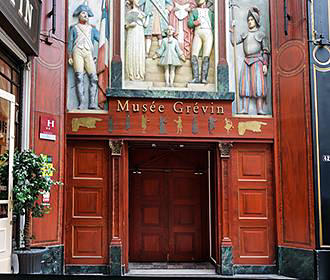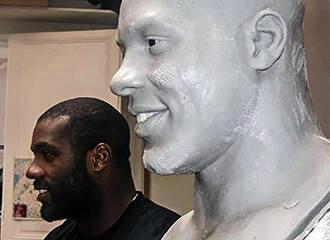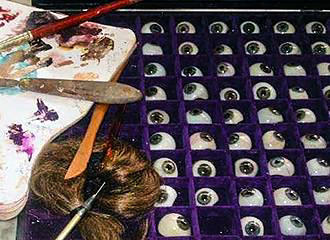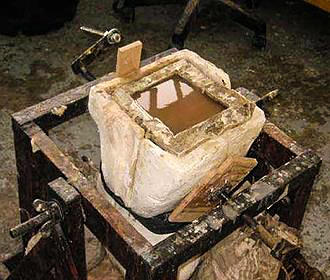Paris Musee Grevin waxworks museum history
The Musee Grevin is the waxwork museum in Paris with a rich history that started in 1882, and still fascinates its visitors year after year where you can pose for pictures with some of the famous celebrities of today and times gone by.
The Musee Grevin waxworks museum history
Originally, back in the late 19th century, most newspapers were just written stories and the public were unable to put a face to a famous name unless there was a sketch or caricature produced for the paper.
So, it all started when Arthur Meyer, a journalist and founder of the daily newspaper called the Le Gaulois, who came up with an idea of displaying representations of famous celebrities that were appearing on the front pages of his newspaper.
In 1881 Arthur Meyer called upon a gentleman by the name of Alfred Grevin, who was a cartoonist, sculptor and designer of theatrical costumes, that often used to produce sketches and caricatures for his paper and after running the idea by him, he became fully involved with getting the project up and running.
In fact, Alfred Grevin became so involved that the place was named after him, and hence the name Musee Grevin, which first opened its doors to the public on 5th June 1882, becoming an overnight success.
Then in 1883, a distinguished investor called Gabriel Thomas became involved, backing the Musee Grevin waxworks museum and he made it more into a business venture to enable a more rapid expansion programme.
Gabriel Thomas enriched the site with fantastic decors such as the Grevin Theatre with its discreet atmosphere and celebrities in evening dress, plus the Palais des Mirages or Hall of Mirrors with its sound and light show was created for the 1900 Universal Exhibition, and eventually this was moved to the Musee Grevin in 1906.
Then in 2001 the Grevin Academy was created, and following the tradition of its founder, the members are distinguished journalists who meet twice a year at the Plaza Athenee Hotel in Paris to discuss and select which celebrities will be entering the Musee Grevin.
To this day, well over 100 years later and after major renovations in 2006, the Musee Grevin Waxworks Museum is still turning heads and enthralling people from all over the world that visit this museum with its sumptuous decor that has been put onto the list of historical Paris monuments.
However, the Musee Grevin history does not stop there, as they have actually expanded internationally, with a waxworks museum opening up in Montreal, Quebec, Canada in 2013, another in Prague, Czech Republic in 2014 and a further museum in Seoul, South Korea in 2015, all under the Grevin brand.
Behind the scenes of the Musee Grevin waxworks museum
The creation of a new wax figure takes a lot of time and effort and there are several sculptors who work for the Musee Grevin full time and there are many different phases before you can get to see the finished sculpture.
To start with, if at all possible, the sculptor and the technical team from the Musee Grevin will take photographs and videos of the subject along with 3D imagery, measurements of the face and body along with casts such as of the hands for instance like in the case of the waxwork of the well known and famous actor Nicolas Cage that was produced in 2011.
However, this is not always the case and sometimes they have to work purely from photographs, videos, films and sketches as they had to for the Spanish actress Penelope Cruz or the most famous prehistoric squirrel, named Scrat, from the Ice Age movies, which was completed in mid 2012.
A clay model of the face is the first stage of production, and where possible it will be with the portrayed person sitting for the artist, and the bodies are then also modelled in clay but using stand-ins rather than the actual celebrity.
Once the sculpture has been completed, they make a plaster and elastomere mould of the sculpture, and wax is cast into the mould for the face, yet the rest of the body is made of resin.
Now when it comes to extracting the face from the mould, it goes straight to the make-up shop, with the eyes being made of glass of medical grade precision, and in many cases these will be selected with the celebrity present. The hair is completely natural and incredibly each one is implanted individually, but this means that on some figures there could be as many as 500,000 individual hairs!
All of the teeth are made by a professional dental specialist and the face itself is made up with oil paints, but defining every single little detail from a beauty spot through to a scar, or even shadows around the eyes and an individual face takes on average 150 hours to complete.
Obviously the figure has to be dressed and when it comes to period costumes, these are manufactured at the Musee Grevin workshops utilising historical documents, but when it comes to contemporary celebrities it is often their favourite dress designer who makes the costume, or they provide the museum with one of their own outfits, just like the actor Nicolas Cage or the basketball player Tony Parker did.
The final stage in a new production relates to the accessories, and these play just as an important role to make the whole scene as authentic as possible and the accessories often belonged to the character portrayed, just like the authentic hip-bath in which Jean-Paul Marat was assassinated or the harpsichord that Mozart was supposed to have used.
Eventually, the waxwork figure is ready to be put on display within the Musee Grevin, and more often than not, for those that have been chosen who are alive and within the press, the celebrity themselves will often be present at the official inauguration, just as even Michael Jackson did many years ago.



